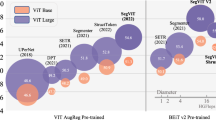Abstract
As a preprocessing step for computer vision tasks, research on generating superpixels of an image has been widely conducted recently. In this paper, we propose a fully automatic superpixel generation algorithm by simplifying the 3D triangle mesh modeled from a 2D input image. The simplification is performed based on a modified quadric error metric (QEM) method. The pipeline of our algorithm is simple. Given an image, we first turn it into a 2D triangle mesh and then lift the mesh to 3D based on the gray values of the image. We then simplify the 3D mesh based on the modified QEM method which encodes the features in the image intrinsically to ensure feature-aware superpixels. After obtaining the simplified mesh, we map it back to the 2D image to generate triangular-shaped superpixels. Our algorithm is fully automatic. The number of superpixels can be controlled intuitively. Experimental results demonstrate the effectiveness of our approach.







Similar content being viewed by others
References
Xie, Y., Xu, L., Wang, Z.: Automated co-superpixel generation via graph matching. Signal Image Video Process. 8(4), 753–763 (2014)
Du, Q., Gunzburger, M., Ju, L., et al.: Centroidal Voronoi tessellation algorithms for image compression, segmentation, and multichannel restoration. J. Math. Imaging Vis. 24(2), 177–194 (2006)
Wang, J., Ju, L., Wang, X.: An edge-weighted centroidal Voronoi tessellation model for image segmentation. IEEE Trans. Image Process. 18(8), 1844–1858 (2009)
Liu, J., Tai, X., Huang, H., et al.: A fast segmentation method based on constraint optimization and its applications: intensity inhomogeneity and texture segmentation. Pattern Recogn. 44(9), 2093–2108 (2011)
Wang, J., Wang, X.: VCells: simple and efficient superpixels using edge-weighted centroidal Voronoi tessellations. IEEE Trans. Pattern Anal. Mach. Intell. 34(6), 1241–1247 (2012)
Wu, Q., Yu, Y.: Two-level image segmentation based on region and edge integration. DICTA, pp. 957–966 (2003)
Spanel, M., Krsek, P.: Vector-based medical image segmentation using adaptive Delaunay triangulation. In: Proceedings of the Sixth IASTED International Conference on Visualization, Imaging, and Image Processing, Palma de Mallorca, ES, ACTA Press, p. 6 (2006)
Sood, S., Krishnamurthy, A.: Triangulation cut for image segmentation. In: IEEE International Conference on Acoustics, Speech and Signal Processing, ICASSP 2008. IEEE 2008, 941–944 (2008)
Li, H., Wu, W., Wu, E.: Robust interactive image segmentation via graph-based manifold ranking. Comput. Vis. Media 1(3), 183–195 (2015)
Xu, L., Zeng, L., Wang, Z.: Saliency-based superpixels. SIViP 8(1), 181–190 (2014)
Qi, W., Cheng, M.M., Borji, A., et al.: SaliencyRank: two-stage manifold ranking for salient object detection. Comput. Visual Media 1(4), 309–320 (2015)
Yin, X., Femiani, J., Wonka, P., et al.: A new qem for parametrization of raster images. In: Computer Graphics Forum. Blackwell Publishing Ltd 30(8), 2440–2451 (2011)
Wang, Q., Spratling, M.W.: A simplified texture gradient method for improved image segmentation. Signal Image Video Process. 10(4), 679–686 (2016)
Felzenszwalb, P.F., Huttenlocher, D.P.: Efficient graph-based image segmentation. Int. J. Comput. Vis. 59(2), 167–181 (2004)
Veksler, O., Boykov, Y., Mehrani, P.: Superpixels and supervoxels in an energy optimization framework. In: Computer Vision—ECCV 2010, European Conference on Computer Vision, Heraklion, Crete, Greece, September 5–11, 2010, Proceedings, pp. 211–224 (2010)
Zhang, Y., Li, X., Gao, X., Zhang, C.: A simple algorithm of superpixel segmentation with boundary constraint. IEEE Trans. Circuits Syst. Video Technol. doi:10.1109/TCSVT.2016.2539839
Shen, J., Du, Y., Wang, W., et al.: Lazy random walks for superpixel segmentation. IEEE Trans. Image Process. 23(4), 1451–1462 (2014)
Dong, X., Shen, J., Shao, L., et al.: Sub-Markov random walk for image segmentation. IEEE Trans. Image Process. 25(2), 516–527 (2016)
Shen, J., Du, Y., Li, X.: Interactive segmentation using constrained Laplacian optimization. IEEE Trans. Circuits Syst. Video Technol. 24(7), 1088–1100 (2014)
Liang, Y., Shen, J., Dong, X., et al.: Video supervoxels using partially absorbing random walks. IEEE Trans. Circuits Syst. Video Technol. (2015). doi:10.1109/TCSVT.2015.2406232
Levinshtein, A., Stere, A., Kutulakos, K.N., et al.: TurboPixels: fast superpixels using geometric flows. IEEE Trans. Pattern Anal. Mach. Intell. 31(12), 2290–2297 (2009)
Achanta, R., Shaji, A., Smith, K., et al.: SLIC superpixels compared to state-of-the-art superpixel methods. IEEE Trans. Pattern Anal. Mach. Intell. 34(11), 2274–2282 (2012)
Van den Bergh, M., Boix, X., Roig, G.: Seeds: superpixels extracted via energy-driven sampling. In: Computer Vision C ECCV, et al.: Springer. Berlin Heidelberg 2012, 13–26 (2012)
Moore, A.P., Prince, J.D., Warrell, J.: Superpixel lattices. In: Computer Vision and Pattern Recognition et al.: CVPR 2008. IEEE Conference on. IEEE 2008, 1–8 (2008)
Garland, M., Heckbert, P.S.: Surface simplification using quadric error metrics. In: Proceedings of the 24th annual conference on Computer graphics and interactive techniques. ACM Press/Addison-Wesley Publishing Co., pp. 209–216 (1997)
Hoppe, H.: New quadric metric for simplifiying meshes with appearance attributes. In: Proceedings of the conference on Visualization’99: celebrating ten years. IEEE Computer Society Press, pp. 59–66 (1999)
Martin, D., Fowlkes, C., Tal, D.: A database of human segmented natural images and its application to evaluating segmentation algorithms and measuring ecological statistics. In: Computer Vision, 2001. ICCV, et al.: Proceedings. Eighth IEEE International Conference on. IEEE 2001(2), 416–423 (2001)
Acknowledgments
This work is supported by the National Nature Science Foundation of China (61332015, 61373078, 61272245) and NSFC Joint Fund with Guangdong (U1201258).
Author information
Authors and Affiliations
Corresponding author
Rights and permissions
About this article
Cite this article
Zhang, Y., Ma, L., Zhou, Y. et al. Automatic superpixel generation algorithm based on a quadric error metric in 3D space. SIViP 11, 471–478 (2017). https://doi.org/10.1007/s11760-016-0983-5
Received:
Revised:
Accepted:
Published:
Issue Date:
DOI: https://doi.org/10.1007/s11760-016-0983-5




